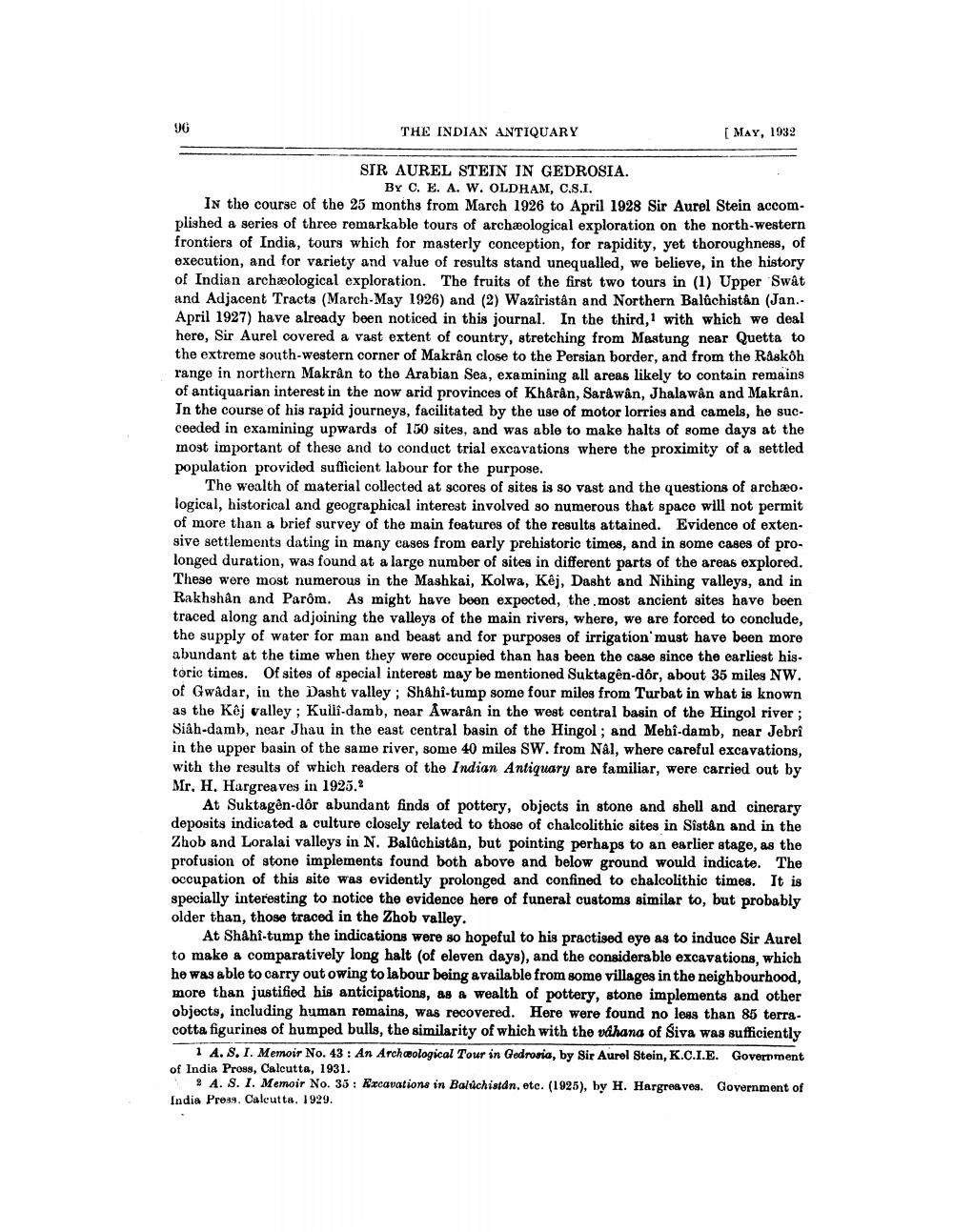________________
THE INDIAN ANTIQUARY
MAY, 1932
SIR AUREL STEIN IN GEDROSIA.
BY C. E. A. W. OLDHAM, C.S.I. In the course of the 25 months from March 1926 to April 1928 Sir Aurel Stein accomplished a series of three romarkable tours of archæological exploration on the north-western frontiers of India, tours which for masterly conception, for rapidity, yet thoroughness, of execution, and for variety and value of results stand unequalled, we believe, in the history of Indian archæological exploration. The fruits of the first two tours in (1) Upper Swât and Adjacent Tracts (March-May 1926) and (2) Wazîristan and Northern Balûchistán (Jan.. April 1927) have already been noticed in this journal. In the third, with which we deal here, Sir Aurel covered a vast extent of country, stretching from Mastung near Quetta to the extreme south-western corner of Makrân close to the Persian border, and from the Raskôh range in northern Makrán to the Arabian Sea, examining all areas likely to contain remains of antiquarian interest in the now arid provinces of Khârân, Sarawân, Jhalawân and Makrân. In the course of his rapid journeys, facilitated by the use of motor lorries and camels, he succeeded in examining upwards of 150 sites, and was able to make halts of some days at the most important of these and to conduct trial excavations where the proximity of a settled population provided sufficient labour for the purpose.
The wealth of material collected at scores of sites is so vast and the questions of archæo. logical, historical and geographical interest involved so numerous that space will not permit of more than a brief survey of the main features of the results attained. Evidence of extensive settlements dating in many cases from early prehistoric times, and in some cases of prolonged duration, was found at a large number of sites in different parts of the areas explored. These were most numerous in the Mashkai, Kolwa, Kêj, Dasht and Nihing valleys, and in Rakhshan and Parôm. As might have been expected, the most ancient sites have been traced along and adjoining the valleys of the main rivers, where, we are forced to conclude, the supply of water for man and beast and for purposes of irrigation must have been more abundant at the time when they were occupied than has been the case since the earliest his. toric times. Of sites of special interest may be mentioned Suktagen-dôr, about 35 miles NW. of Gwadar, in the Dasht valley ; Shahî-tump some four miles from Turbat in what is known as the Kêj valley; Kulli-damb, near Awarân in the west central basin of the Hingol river; Siâh-damb, near Jhau in the east central basin of the Hingol; and Mehi-damb, near Jebri in the upper basin of the same river, some 40 miles SW. from Nal, where careful excavations, with the results of which readers of the Indian Antiquary are familiar, were carried out by Mr. H. Hargreaves in 1925.
At Suktagên-dôr abundant finds of pottery, objects in stone and shell and cinerary deposits indicatod a culture closely related to those of chalcolithic sites in Sistan and in the Zhob and Loralai valleys in N. Balûchistân, but pointing perhaps to an earlier stage, as the profusion of stone implements found both above and below ground would indicate. The occupation of this site was evidently prolonged and confined to chalcolithic times. It is specially interesting to notice the evidence here of funeral customs similar to, but probably older than, those traced in the Zhob valley.
At Shahi-tump the indications were so hopeful to his practised eye as to induce Sir Aurel to make a comparatively long halt (of eleven days), and the considerable excavations, which he was able to carry out owing to labour being available from some villages in the neighbourhood, more than justified his anticipations, as a wealth of pottery, stone implements and other objects, including human remains, was recovered. Here were found no less than 85 terracotta figurines of humped bulls, the similarity of which with the vdhana of Siva was sufficiently
1 A.S.I. Memoir No. 43 : An Archological Tour in Gedrosia, by Sir Aurel Stein, K.C.I.E. Government of India Pross, Calcutta, 1931.
% S. 1. Memoir No. 35 : Excavations in Baluchistan, etc. (1925), by H. Hargreaves. Government of India Press, Calcutta, 1929.




